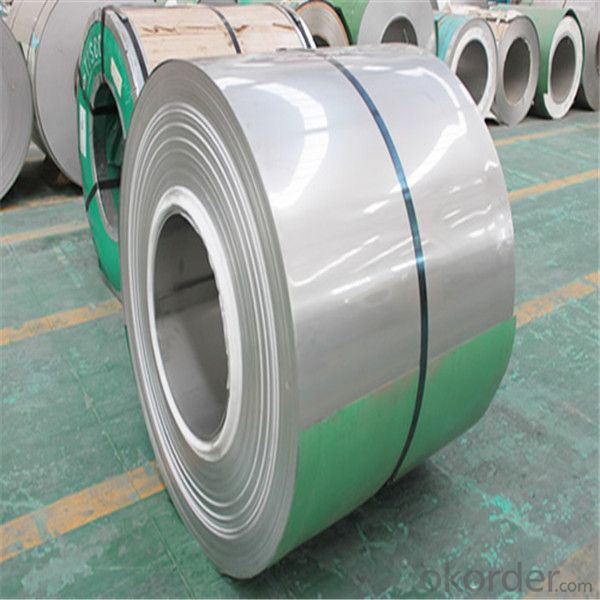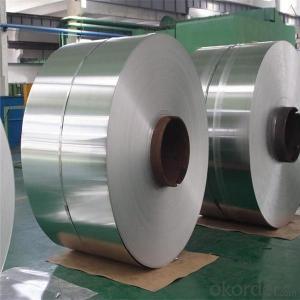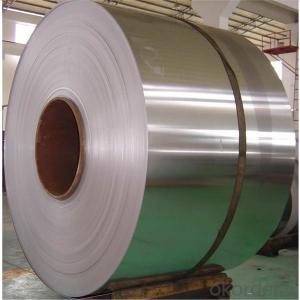201/304/430/ Stainless Steel Coil with good quality
- Loading Port:
- Shanghai
- Payment Terms:
- TT OR LC
- Min Order Qty:
- 5 m.t.
- Supply Capability:
- 24000 m.t./month
OKorder Service Pledge
OKorder Financial Service
You Might Also Like
Item specifice
stainless steel coil
1. Standard: ASTM A240, JIS G4304, G4305, GB/T 4237, GB/T 8165, BS 1449, DIN17460, DIN 17441
2. Grade: 200series&300series&400series
3. Thickness: 0.23mm-0.8mm
4. Diameter: 115-560mm
5. Length: according buyer require
6. Surface finish: 2B, BA, 8K, 6K, Mirror Finished, No1, No2, No4, Hair Line with PVC
7. Manufacture technology: cold drawn/cold rolled/hot rolled
1.Export Markets
Our target market is the international market. Every year we export most of products to countries like India, Pakistan, South Korea, Brazil, Australia, South Africa, Spain, Sri Lanka, russia,vietnam,Taiwan, Hong Kong, etc.
Type | Stainless steel coil (cold rolled ) |
Thinckness | 0.23mm-0.8mm |
Diameter | 115mm-560mm |
Quantity | as customer's requirement |
Finish | 2B,BA,HL,MIRROR,NO.1-NO.4,8K,and so on. |
Standard | ASME, ASTM, EN ,BS,GB,DIN, JIS etc |
Material | 201,202, 301,304,410,430,409 |
Application range | Foodstuff, Gas, metallurgy, biology, electron, chemical, petroleum, boiler, nuclear energy, Medical equipment, fertilizer etc |
Package | Standard export sea-worthy packing |
Delivery time | 7-15 days |
Quality | No.1 |
Productivity | 3000-4000 tons/month |
Note | We can produce other standard as the customers’ requirement |
2.Technical notes:
Surface Finish | Definition | Application |
2B | Those finished, after cold rolling, by heat treatment, pickling or other equivalent treatment and lastly by cold rolling to given appropriate luster. | Medical equipment, Food industry, Construction material, Kitchen utensils. |
BA | Those processed with bright heat treatment after cold rolling. | Kitchen utensils, Electric equipment, Building construction. |
NO.3 | Those finished by polishing with No.100 to No.120 abrasives specified in JIS R6001. | Kitchen utensils, Building construction. |
NO.4 | Those finished by polishing with No.150 to No.180 abrasives specified in JIS R6001. | Kitchen utensils, Building construction, Medical equipment. |
HL | Those finished polishing so as to give continuous polishing streaks by using abrasive of suitable grain size. | Building Construction. |
NO.1 | The surface finished by heat treatment and pickling or processes corresponding there to after hot rolling. | Chemical tank, pipe |
3.chemcial composition
Quality | Copper | NI | CU | Application |
PURE DDQ
| High | 1% | 1.4% | Sink, Deep drawing product |
DDQ | Middle | 1% | 1% | Pot, Bowl |
non-DDQ | Low | 0.5% | 0.5% | Plate, Bowl |


- Q:Can 111 stainless steel strips be stamped or embossed for decorative purposes?
- Certainly! It is possible to stamp or emboss 111 stainless steel strips for decorative intentions. Stainless steel is an adaptable substance that can undergo different manufacturing procedures, including stamping and embossing. The process of stamping entails pressing or molding the stainless steel strip with a die, whereas embossing generates elevated or sunken designs on the surface. Both methods can be employed to incorporate decorative patterns, logos, or textures onto the stainless steel strips, rendering them appropriate for decorative purposes in various industries like interior design, architecture, automotive, or consumer goods.
- Q:What is the toughness of stainless steel strips?
- Stainless steel strips possess remarkable toughness, known for their ability to endure substantial stress and resist deformation or breakage in extreme circumstances. This is attributable to the distinct characteristics of stainless steel, which include its formidable tensile strength and exceptional resistance to impact. In sectors that demand resilience and sturdiness, such as construction, automotive, and aerospace industries, stainless steel strips are frequently employed. They exhibit the capacity to withstand heavy loads, combat corrosion, and uphold their structural integrity even in harsh surroundings. Consequently, stainless steel strips are widely esteemed for their durability and dependability, rendering them a favored option across diverse industries.
- Q:Are stainless steel strips suitable for artistic installations?
- Yes, stainless steel strips are suitable for artistic installations. It is a versatile and durable material that can be shaped, manipulated, and polished to create various artistic designs. Its resistance to corrosion and ability to withstand different weather conditions make it an ideal choice for both indoor and outdoor installations. Additionally, stainless steel's sleek and modern appearance can enhance the aesthetic appeal of artistic installations, making it a popular choice among artists and designers.
- Q:What are the advantages of using stainless steel strips?
- There are several advantages of using stainless steel strips in various applications. Firstly, stainless steel is known for its exceptional corrosion resistance. It can withstand exposure to moisture, chemicals, and other harsh environmental conditions without rusting or corroding. This makes it an ideal choice for applications that require long-lasting durability, such as in the construction industry or for outdoor equipment. Secondly, stainless steel strips offer excellent strength and stability. They have a high tensile strength, which means they can withstand heavy loads and pressure without deforming. This makes them suitable for applications that require structural integrity, such as in automotive manufacturing or in the production of machinery parts. Additionally, stainless steel is highly hygienic and easy to clean. It is non-porous, which means it does not trap dirt, bacteria, or other contaminants. This makes it a popular choice for applications in the food and beverage industry, medical equipment, and pharmaceutical manufacturing. Moreover, stainless steel strips have a high heat resistance, allowing them to withstand extreme temperatures without deforming or losing their strength. This makes them suitable for applications in high-temperature environments, such as in the aerospace industry or in the manufacturing of industrial furnaces. Furthermore, stainless steel is aesthetically pleasing and can be easily customized. It has a sleek and modern appearance, making it a popular choice in architecture and interior design. It can also be easily shaped, welded, and polished, allowing for various design possibilities. Lastly, stainless steel is a sustainable and environmentally friendly material. It is 100% recyclable, which reduces the need for new raw materials and minimizes waste. Additionally, stainless steel does not release harmful substances or toxins during its production, making it safe for both human health and the environment. Overall, the advantages of using stainless steel strips include corrosion resistance, strength, hygiene, heat resistance, customization options, and sustainability. These qualities make stainless steel a versatile and reliable material for a wide range of applications in various industries.
- Q:What is the creep strength of stainless steel strips?
- The creep strength of stainless steel strips refers to the ability of the material to resist deformation or creep under high temperatures and constant stress. Stainless steel is known to have good creep strength, making it suitable for applications that involve elevated temperatures and long-term loads.
- Q:Are stainless steel strips resistant to hydrogen embrittlement?
- Yes, stainless steel strips are generally resistant to hydrogen embrittlement due to their microstructure and high alloy content, which prevent hydrogen atoms from diffusing and causing embrittlement. However, certain factors such as high-strength grades or specific environmental conditions can still lead to hydrogen embrittlement in stainless steel strips.
- Q:Are stainless steel strips suitable for elevator interiors?
- Elevator interiors can benefit from the use of stainless steel strips, which are highly suitable for this purpose. Stainless steel is a versatile and durable material that finds widespread use in various applications, including elevator interiors. Its exceptional properties make it an ideal choice for this application, as it resists corrosion, requires minimal maintenance, and maintains a polished and sleek appearance over time. By incorporating stainless steel strips, the elevator interior's aesthetic appeal can be enhanced, resulting in a modern and sophisticated look. Moreover, stainless steel is easy to clean and sanitize, ensuring a hygienic environment, especially in areas with high foot traffic. In conclusion, stainless steel strips offer a practical and suitable option for elevator interiors, combining durability and aesthetic charm.
- Q:Are 111 stainless steel strips suitable for food processing equipment?
- Yes, 111 stainless steel strips are suitable for food processing equipment. Stainless steel is widely used in the food industry due to its excellent corrosion resistance, strength, and hygienic properties. The 111 stainless steel grade, which is also known as Grade 304, is one of the most common and versatile stainless steel grades used in food processing equipment. It is highly resistant to corrosion from acids, alkalis, and other chemicals found in food processing environments. Additionally, Grade 304 stainless steel is non-porous, making it easy to clean and maintain high levels of hygiene. Therefore, 111 stainless steel strips would be a suitable choice for food processing equipment.
- Q:Are stainless steel strips resistant to intergranular corrosion?
- Yes, stainless steel strips are generally resistant to intergranular corrosion. This is because stainless steel contains a minimum of 10.5% chromium, which forms a protective oxide layer on the surface of the steel. This oxide layer acts as a barrier, preventing oxygen and moisture from reaching the underlying metal and causing corrosion. Additionally, stainless steel strips often contain other alloying elements such as nickel, molybdenum, or titanium, which further enhance their resistance to corrosion. However, it is important to note that the resistance to intergranular corrosion can vary depending on the specific grade of stainless steel being used and the conditions it is exposed to. Some grades of stainless steel may be susceptible to intergranular corrosion under certain circumstances, such as exposure to high temperatures or certain chemical environments. Therefore, it is essential to choose the appropriate grade of stainless steel based on the specific application and environmental conditions to ensure optimal corrosion resistance.
- Q:Are stainless steel strips resistant to fire?
- Yes, stainless steel strips are highly resistant to fire. Stainless steel is known for its exceptional heat resistance properties. It has a high melting point, which means it can withstand high temperatures without losing its structural integrity. Stainless steel strips also have a low thermal conductivity, meaning they do not conduct heat well, making them more resistant to fire. Additionally, stainless steel contains chromium, which forms a protective oxide layer on its surface when exposed to heat. This oxide layer acts as a barrier, preventing oxygen from reaching the steel and further enhancing its fire resistance. As a result, stainless steel strips are widely used in various applications where fire resistance is a critical requirement, such as construction, automotive, and aerospace industries.
1. Manufacturer Overview |
|
|---|---|
| Location | |
| Year Established | |
| Annual Output Value | |
| Main Markets | |
| Company Certifications | |
2. Manufacturer Certificates |
|
|---|---|
| a) Certification Name | |
| Range | |
| Reference | |
| Validity Period | |
3. Manufacturer Capability |
|
|---|---|
| a)Trade Capacity | |
| Nearest Port | |
| Export Percentage | |
| No.of Employees in Trade Department | |
| Language Spoken: | |
| b)Factory Information | |
| Factory Size: | |
| No. of Production Lines | |
| Contract Manufacturing | |
| Product Price Range | |
Send your message to us
201/304/430/ Stainless Steel Coil with good quality
- Loading Port:
- Shanghai
- Payment Terms:
- TT OR LC
- Min Order Qty:
- 5 m.t.
- Supply Capability:
- 24000 m.t./month
OKorder Service Pledge
OKorder Financial Service
Similar products
New products
Hot products
Related keywords




























